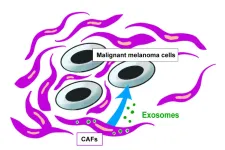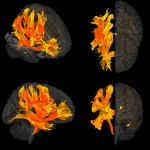(Press-News.org) INDIANAPOLIS, March 28, 2023 — Have a cough, sore throat and congestion? Any number of respiratory viruses could be responsible. Conventional tests can identify certain likely culprits by relying on chemical reactions, but some researchers want to swap chemistry for electrical changes sensed by nanomaterials. Today, scientists report using a single-atom-thick nanomaterial to build a device that can simultaneously detect the presence of the viruses that cause COVID-19 and the flu — at much lower levels and much more quickly than conventional tests for either.
The researchers will present their results at the spring meeting of the American Chemical Society (ACS). ACS Spring 2023 is a hybrid meeting being held virtually and in-person March 26–30, and features more than 10,000 presentations on a wide range of science topics.
The symptoms of both flu and COVID-19 overlap considerably, making it difficult to distinguish between them, notes Deji Akinwande, Ph.D., who is presenting the work at the meeting.
“When both of these viruses are circulating together as they did earlier this winter, it would be immensely useful to have a sensor that can simultaneously detect whether you have COVID, flu, none of the above or both,” he says.
Akinwande, who is at The University of Texas at Austin, says that the device he and colleagues are developing could be modified to test for other infections as well.
The group, including Dmitry Kireev, Ph.D., a postdoc in Akinwande’s lab, constructed the COVID-19 and flu sensor using graphene, a single layer of carbon atoms arranged in a hexagonal lattice pattern. Its extreme thinness renders graphene highly sensitive to any electrical changes in its environment. Akinwande and other researchers see enormous potential in using it and other, similar nanomaterials to create sensors for many different applications.
“These ultra-thin nanomaterials generally hold the record for best sensitivity, even down to the detection of single atoms, and they can improve the ability to detect very small quantities of basically anything that needs to be sensed, whether it’s bacteria or viruses, in gas or in blood,” Akinwande says.
Previously, his group reported designing a graphene-based temporary tattoo that could monitor blood pressure. The tattoo consists of pairs of sensors placed along the arteries of the arm. One half of each pair sends out an electrical current that its partner detects. This signal is used to determine blood flow.
To build the infection sensor, the researchers had to make graphene respond to the presence of viral protein. To do so, they looked to the immune system, which produces antibodies that are fine-tuned to recognize and latch onto particular pathogens. The researchers linked antibodies against SARS-CoV-2, the virus that causes COVID-19, and against the flu virus to graphene. When a sample from an infected person is placed on the sensor, these antibodies bind to their target proteins, prompting a change in the electrical current.
The researchers did not have the safety facilities needed to use whole, active flu or SARS-CoV-2 viruses to test the roughly square-inch sensor. To substitute, they used proteins from these viruses delivered in fluid intended to resemble saliva. Their results indicated that not only could the sensor detect the presence of the proteins, it could do so when they were present at extremely low quantities. This sensitivity suggested the sensor could be used for detecting the much more sparse viral particles found in breath, Akinwande says.
The sensor also worked quickly, returning results within about 10 seconds of dropping in a sample, he says. By comparison, conventional COVID-19 tests can take minutes or hours, depending on the type, and a dual COVID and flu test recently authorized by the U.S. Food and Drug Administration takes about half an hour to produce results.
Akinwande and his group are working to improve its performance further, including by expanding the slate of viruses it can detect. With funding from the National Science Foundation, they are developing a sensor designed to test for SARS-CoV-2 variants, such as omicron and delta. While they are currently focusing on a two-variant design, the test could be adapted to simultaneously identify even more, they say.
The researchers acknowledge support and funding from the National Science Foundation.
For health and safety information for ACS Spring 2023, please visit the FAQ webpage.
The American Chemical Society (ACS) is a nonprofit organization chartered by the U.S. Congress. ACS’ mission is to advance the broader chemistry enterprise and its practitioners for the benefit of Earth and all its people. The Society is a global leader in promoting excellence in science education and providing access to chemistry-related information and research through its multiple research solutions, peer-reviewed journals, scientific conferences, eBooks and weekly news periodical Chemical & Engineering News. ACS journals are among the most cited, most trusted and most read within the scientific literature; however, ACS itself does not conduct chemical research. As a leader in scientific information solutions, its CAS division partners with global innovators to accelerate breakthroughs by curating, connecting and analyzing the world’s scientific knowledge. ACS’ main offices are in Washington, D.C., and Columbus, Ohio.
To automatically receive news releases from the American Chemical Society, contact newsroom@acs.org.
Note to journalists: Please report that this research was presented at a meeting of the American Chemical Society.
Follow us: Twitter | Facebook | LinkedIn | Instagram
Title
Unconventional applications of 2D materials from memory devices to Covid sensors and wearable health
Abstract
This talk will present our latest research findings on 2D nanomaterials towards greater scientific understanding and advanced engineering applications. In particular, the talk will highlight our work on zero-power devices, single-atom monolayer memory and applications, Covid diagnostic sensors and wearable tattoo sensors for mobile health. Non-volatile memory devices based on 2D materials are an application of defects and is a rapidly advancing field with rich physics that can be attributed to metal adsorption into vacancies. The memory devices can be used for neuromorphic computing and operate as communication switches up to 500GHz. Likewise, from a practical point, electronic tattoos based on graphene have ushered a new material platform that has highly desirable practical attributes including optical transparency, mechanical imperceptibility, and is the thinnest conductive electrode sensor that can be integrated on skin for physiological measurements including blood pressure monitoring with clinical accuracy. Most recently, significant progress has been made with 2D materials for rapid Covid diagnostic sensors.
END
Is it COVID-19 or the flu? New sensor could tell you in 10 seconds
2023-03-28
ELSE PRESS RELEASES FROM THIS DATE:
Shedding pounds may benefit your heart — even if some weight is regained
2023-03-28
Research Highlights:
Weight loss was associated with decreased risk factors for cardiovascular disease and Type 2 diabetes for at least five years — even if some weight was regained, according to a review of research on behavioral weight loss programs.
People who lost weight through an intensive behavioral weight loss program had lower systolic blood pressure levels, total cholesterol-to-good cholesterol ratio and HbA1c levels (a diabetes marker), when compared to people who did not participate in a program or participated in a lower-intensity behavioral program.
Embargoed ...
Turtles and crocodiles with unique characteristics are more likely to go extinct
2023-03-28
New research led by the University of Oxford has revealed that the most endangered turtle and crocodile species are those that are most unique. Their loss could have widespread impacts on the ecosystems they live in, since they carry out critical processes important for many other species.
Turtles and crocodiles are two of the world's most endangered animal groups, with approximately half of species globally threatened (International Union for Conservation of Nature, IUCN). Greater understanding on which species are most threatened and why is urgently needed to inform conservation efforts to save them.
In a new study led by researchers at the Department of Biology, ...
A final present from birds killed in window collisions: poop that reveals their microbiomes
2023-03-28
Every year, millions of birds crash into windows in cities along their migratory path. For decades, scientists and volunteers have risen at dawn in spring and fall to collect the fallen birds, rehabilitating the injured and documenting the dead. The bodies of the birds killed in these collisions are a treasure trove of scientific information, especially when compared year after year. A new study in the journal Molecular Ecology makes use of these specimens to help understand the relationship between birds and the microbes living in their guts—which appears ...
ISTA welcomes first journalists in residence
2023-03-28
Understanding of and trust in science and scientists are dangerously low, and initial studies suggest that a general lack of interest in science is even more of a problem than skepticism in Austria. A key partner in alleviating this mistrust, clearing up misunderstandings, and building up enthusiasm for science must be the media in general and science journalists in particular. However, these journalists need access to the information as well as the resources to work independently and give full flight to their curiosity and creativity. To work towards these goals and promote excellent science journalism, ISTA initiated a program to host journalists for two-to-four-month ...
Candidate found to inhibit malignant melanoma growth
2023-03-28
Malignant melanoma is a relatively aggressive type of skin cancer. When detected early, it is usually treatable by surgical resection only, but metastases develop often spreading to distant areas. Currently, tumor thickness and the presence of ulceration are some of the known prognostic factors used as indicators of malignant melanoma. Therefore, the discovery of valuable markers to assess the malignant potential of melanoma more accurately may be necessary to develop appropriate treatments.
Cross talk between cancer cells and surrounding stromal cells is ...
New form of omega-3 could prevent visual decline with Alzheimer’s disease
2023-03-28
For the first time, researchers have developed a form of the omega-3 fatty acid docosahexaenoic acid (DHA) that is capable of crossing into the eye’s retina to ward off visual declines related to Alzheimer’s disease, diabetes and other disorders.
The DHA found in fish oil capsules and other supplements is typically in a form called triacylglycerol (TAG) DHA. Although TAG-DHA has benefits in other parts of the body, it does not reach the eyes because it cannot travel from the bloodstream into the retina. For the study, ...
Less ‘risky’ sex of early pandemic still evident year after first lockdown in Britain
2023-03-28
The lower prevalence of ‘risky’ sex—with multiple or new partners without using condoms—which occurred during the early stages of the COVID-19 pandemic, was still evident a year after Britain’s first lockdown, reveal the results of a major national survey, published online in the journal Sexually Transmitted Infections.
While there were fewer reported unplanned pregnancies and abortions than indicated by a comparable survey a decade earlier, there were significantly higher prevailing levels of sexual dissatisfaction and worries ...
Allergic (atopic) asthma/eczema linked to heightened risk of osteoarthritis
2023-03-28
People with atopic (allergic) diseases like asthma or eczema may be at heightened risk of the painful and often disabling joint condition, osteoarthritis, finds research published online in the Annals of the Rheumatic Diseases.
Drugs used to dampen down the physiological prompts for allergic reactions in the body may help lessen this risk, suggest the researchers.
Osteoarthritis is the most common form of arthritis. But despite the high prevalence, substantial costs, and debilitating impact of the disease, there is as yet no effective ...
SMART warnings could protect communities at risk from flooding
2023-03-28
Engaging communities in developing a real-time early warning system could help to reduce the often-devastating impact of flooding on people and property – particularly in mountainous regions where extreme water events are a ‘wicked’ problem, a new study reveals
Flash floods are becoming more frequent and damaging to the lives and property of vulnerable people, but researchers believe that using a SMART approach to engage with those living in such areas will help to better signal impending risk from flooding.
Scientists believe that combining meteorological data with information on how people live and work in such regions, will help disaster risk ...
World first: Researchers identify specific regions of the brain that are damaged by high blood pressure and are involved in a decline in mental processes and dementia
2023-03-28
For the first time, researchers have identified specific regions of the brain that are damaged by high blood pressure and may contribute to a decline in mental processes and the development of dementia.
High blood pressure is known to be involved in causing dementia and damage to brain function. The study, which is published in the European Heart Journal [1] today (Tuesday), shows how this happens. It gathered information from a combination of magnetic resonance imaging (MRI) of brains, genetic analyses and observational data from thousands of patients to look at the effect of high blood pressure on cognitive function. The researchers then checked their findings ...








